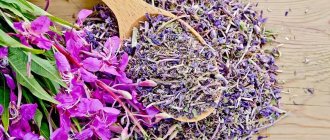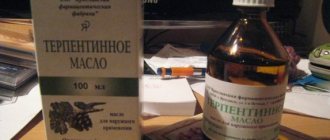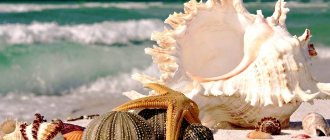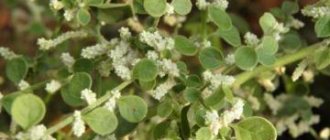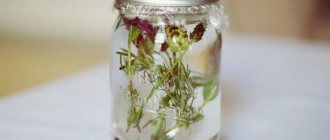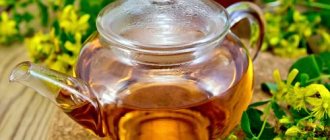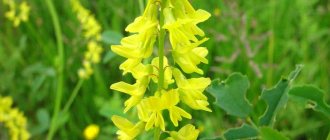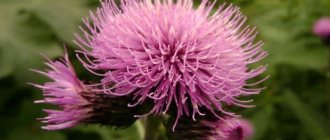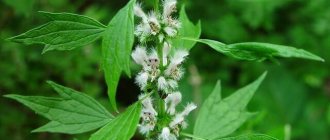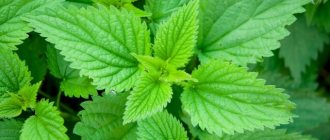Comfrey is a herbaceous plant that belongs to the borage family. Popularly, the herb comfrey was called “larkspur”, since the plant has long been used to quickly heal damaged bones. Comfrey has an anti-inflammatory, antimicrobial, regenerating effect, and also has a beneficial effect on increasing appetite and general tone.
This plant has a long, erect stem, sometimes reaching up to 1.2 meters. The entire stem is covered with stiff hairs. The leaves are located on the branched stem: the lower ones are petiolate, the upper ones are large sessile, oblong-lanceolate in shape with a rough surface. Larkspur leaves have a characteristic cucumber smell.
The rhizome of comfrey is short, black-brown in color, with spindle-shaped black roots, and at the break, grayish-white roots, reaching a length of up to 70 cm.
The flowering period of comfrey is from May to July. Larkspur flowers are small in purple, white-pink or violet, forming paniculate inflorescences among themselves. The fruit is a single-seeded nut and ripens in July - September.
Larkspur can be found throughout almost the entire European part of Russia, as well as in the Caucasus, Western Siberia, Central Asia and the Carpathians. This plant prefers moist peaty soil and grows in wet meadows, forest edges, and near the banks of reservoirs and rivers.
Description of the plant
The thick stems of comfrey easily grow to a height of 1.2 m. They branch profusely and are overgrown with large, up to 15 cm in length, alternate leaves, the length of which shortens as they move upward. The entire plant is abundantly covered with light, stiff hairs, giving it a characteristic roughness.
The rhizome of the larkspur goes to a depth of 50 cm, providing the plant with a successful wintering and reproduction by shoots. The outside of the rhizome is covered with almost black bark; when cut, it is white, juicy, and feels greasy to the touch. The root system of the plant enters into symbiosis with soil nitrogen-fixing bacteria, due to which it accumulates large amounts of protein. To supplement the botanical characteristics, it should be indicated that:
- flowering occurs in May-July;
- the color of the corollas is blue or purple;
- flowers are collected in a curl inflorescence;
- The fruits and nuts ripen by September.
In folk healing practice, comfrey is used, and in total this genus includes 19 species of plants, differing in height, leaf shape and structure of underground organs.
The whole plant is abundantly covered with hairs, giving it a rough appearance.
Botanical description and range of larkspur
About 280 varieties of larkspur are known. The most well-known names of these species are: spur grass, field delphinium, field larkspur, consolid larkspur, reticular larkspur, horned cornflowers, knight's spur. Among these species there are annuals and perennials, but all these plants belong to the herbaceous family Ranunculaceae.
Larkspur (Consolida regalis) is an annual plant that can reach 65–80 cm in height. The stem is erect, covered with short, fairly stiff hairs, with a large number of lateral shoots; the root of the larkspur is taproot.
The foliage growing at the roots is on small petioles, and those leaves that are located on the shoots do not have petioles. The flowers are purple, sometimes light red or white in color, usually collected in a racemose inflorescence, the number of flowers in it is 15 - 20 pieces. The sepals are petal-shaped. Each flower grows spurs - long, narrow, in which nectar accumulates. The fruits are leaflets, arranged singly and devoid of hairs. Larkspur blooms from early June to late August.
Larkspur is an annual
Spur grass reproduces exclusively by seeds (like most weeds). Moreover, seed material most often falls into the soil in the fall after ripening, spends the entire winter in the ground, and in early spring, when the snow melts and the soil warms up, it is one of the first plants to sprout.
The homeland of this poisonous perennial is the European continent, the countries of Transcaucasia and Asia Minor. And this plant was brought to America by settlers.
More than 90 species of spurs grow on the territory of our country and its neighboring states. But the most common types are the following: High larkspur, Field sokiriki. In fields where cultivated plants are planted, this annual plant is found as a weed, on roadsides and wastelands. The best type of soil for this plant is limestone. Moreover, this annual plant is not at all demanding on growing conditions.
Chemical composition and application
Comfrey grass is rich in plant mucilages, organic acids, tannins and pyrrolizidine alkaloids. The main medicinal component of larkspur is the nitrogenous compound allantoin, the content of which in the roots reaches 0.8%. The World Health Organization has included allantoin in the list of local astringents and external analgesics.
Its main use is the healing of injuries from bruises, cuts, dislocations, fractures, pain in the amputation stump. The substance is also used in cosmetic creams to care for sunburned, chapped and excessively dry skin. Ointments with comfrey are used to treat psoriasis, acne, and acne.
The use of comfrey in folk medicine as a remedy is more diverse. Infusions and decoctions of the plant are used as an effective remedy for the treatment of mastitis, periodontal disease, boils, as well as rinses for diseases of the larynx and oral cavity, for the treatment of gastrointestinal diseases.
Comfrey grass is rich in plant mucilage, organic acids and tannins.
Useful properties of comfrey
The scope of application of comfrey as a medicine is varied. On the one hand, it is a good anti-inflammatory agent, on the other hand, it is an effective way to treat and prevent many diseases. All parts of the plant have beneficial properties, but the greatest concentration of vitamins, minerals and macroelements is concentrated in its rhizomes. Benefits of comfrey for the human body:
- the ability to stop external bleeding (an effective remedy for all forms of wounds, including cuts);
- beneficial effect on eliminating symptoms of internal bleeding (for example, gastric or intestinal);
- the ability to accelerate the process of fusion of bone tissue (for dislocations, fractures and other injuries);
- normalization of appetite; helps reduce symptoms of hemorrhoids and other colon diseases;
- reduces symptoms of bronchial asthma and chronic lung diseases;
- reduction of symptoms in cancer;
- decreased blood sugar levels; has an antimicrobial effect on the human body;
- beneficial effect on the respiratory system; elimination of symptoms of musculoskeletal diseases;
- providing an anti-inflammatory effect;
- elimination of pain and consequences of bruises;
- relief from symptoms of diarrhea;
- the ability to speed up the treatment of dental diseases;
- acceleration of the process of restoration of tissues of various groups (bone, skin, etc.);
- restoration of the basic functions of the epithelium;
- accelerating the healing process of burns of varying severity;
- strengthening the intestinal muscles (as well as a beneficial effect on the muscles of the female genital organs);
- providing a therapeutic effect on the skin (for damage, inflammation, allergic reactions, skin diseases);
- elimination of symptoms of colitis of any form;
- increased vitality (especially during the recovery period after illnesses or operations);
- decreased blood pressure;
- stimulation of cell growth and regeneration;
- elimination of symptoms of abnormalities in the functioning of the nervous system;
- acceleration of the process of expectoration of sputum;
- improving metabolism and normalizing digestion.
Medicinal properties and harm
The beneficial properties of comfrey and contraindications for its use are related to the chemical composition of the plant. Allantoin improves the nutrition of dividing cells, promoting bone fusion by accelerating the regeneration of periosteum tissue. It also softens the skin's keratin and stimulates the exfoliation of dead cells and their replacement with new ones. The osmotic properties of allantoin make it possible to clean wounds by removing bacterial waste products.
Rosmarinic acid in comfrey root has an analgesic and anti-inflammatory effect. Thanks to the property of choline to improve capillary blood circulation, hematomas resolve faster. Saponins contained in the grass and roots have an antimicrobial effect.
However, larkspur preparations are used with caution due to the presence of pyrrolizidine alkaloids in them. These substances can block the functioning of the nerve ganglia, thereby causing partial paralysis. They also have carcinogenic and mutagenic properties, which is confirmed by studies on rats. The ratio of benefits and harms of the plant is such that comfrey is prohibited for use in the USA and many other countries. The plant is contraindicated for children, pregnant women and people with chronic hypotension.
Comfrey is banned for use in the US and many other countries.
Contraindications to the use of comfrey
Comfrey is a poisonous plant. It contains the alkaloids cynoglosine consolidine. Significant doses of these alkaloids, accumulating in the body, can provoke paralysis of the central nervous system.
Also, internal use of comfrey can lead to carcinogenic effects and negatively affect the liver. Caution must also be exercised when used externally - it is advisable to apply comfrey tinctures and ointments to undamaged areas.
The use of comfrey by pregnant women is strictly contraindicated.
Propagation and cultivation
In nature, comfrey occupies a wide range, including the forest and steppe zones of the European part of Russia and further west to the Atlantic. The plant prefers well-moistened fertile soils of damp meadows, forest edges, and river floodplains. Larkspur fruits can spread by sticking to the soles of shoes, so it often grows along roads and in home front gardens.
This is an extremely undemanding plant, the only whim of which is its inability to grow in acidic soils. At home, planting the plant is desirable through seed stratification for 2 months on the bottom shelf of the refrigerator. In the northern regions, seedlings are grown for early placement of plants in the garden, starting at the end of February.
For larkspur, select a slightly shaded place: near a fence or outbuilding, in a low area, along a garden path. In the first year of life, the plant forms only a rosette of leaves, so it needs frequent weeding. Subsequently, it will crowd out the weeds on its own. There is no need to protect comfrey from frost, but it will have to be systematically thinned out so that it does not take up too much space.
Comfrey prefers well-moistened soils
Collection, preparation, storage and recipes
Comfrey roots are used for medicinal purposes, since by winter they accumulate the maximum amount of allantoin. Raw materials are harvested in late autumn or after the snow melts. The roots are dug up, rinsed, dried, cut into pieces and dried at a temperature of 40 degrees. They can be stored in fabric bags, cardboard or wooden containers for no more than 3 years.
You can also use fresh larkspur root. It is grated, mixed with a small amount of vegetable oil and applied to bruises, contusions, sore joints and ligaments. In winter, to prepare such a paste, dry root powder is poured with warm water, after softening, excess liquid is squeezed out and mixed with oil.
To prepare comfrey infusions, pour a tablespoon of root crushed in a coffee grinder into a glass of boiling water and leave under a flannel cap for 2 hours. After filtering, use as compresses or drink 1 tablespoon every 2 hours for fractures.
You can also prepare medicine from comfrey root in the form of a tincture. To do this, pour 2 tablespoons of the root into a liter of high-quality vodka and leave in a dark place for 2 weeks, shaking daily. The finished tincture is used for rubbing for joint diseases.
Comfrey roots are used for medicinal purposes.
When and how to collect comfrey leaves and rhizomes. Harvesting a medicinal plant
Medicinal recipes of traditional medicine consider the use of roots and leaves of the plant.
How to prepare leaves
The stems with leaves are collected during the flowering period, they are used fresh, and stored in the refrigerator for no more than a day. In summer, fresh leaves can be applied to the affected joints. But you should remember that the plant is poisonous and follow safety rules. After contact with the grass, you should wash your hands with soap.
Harvesting larkspur roots
Larkspur root is harvested in early spring or late autumn, when it contains a large accumulation of allantoin. The roots are taken out of the ground, rinsed and dried a little. Cut into pieces and dry in a well-ventilated area away from sunlight or in an electric dryer. Store finished raw materials in wooden, cardboard or fabric containers for 3 years.
Is comfrey a borage herb or not?
Like many other plants, larkspur has received many names among the people, and among them is borage. The fact is that the leaves of the plant, crushed between the fingers, emit a distinct smell of fresh cucumber. This phenomenon is due to the presence of small amounts of similar essential oils in comfrey and cucumbers. Therefore, comfrey and borage are one and the same.
But comfrey has nothing in common with a plant called larkspur. They even belong to unrelated families. Nevertheless, their purpose in folk medicine is similar - to treat skeletal injuries.
Pharmaceutical products based on comfrey
In addition to its use in folk medicine, bonebreaker grass is used to make various pharmaceutical medicines. Comfrey extract is added to the April gel, Boswellia body balm, and Sustavit cream-balm. In addition, tinctures for internal use are sold.
released the drug Zhivokost in tablet form. In addition to the active ingredient, the composition includes lactose. The drug can be used not only as an adjuvant in the treatment of joint diseases, but also to prevent the development of such pathologies. When using a comfrey-based product, the instructions for use must be followed exactly. The drug should be taken for 8-12 weeks, the course is repeated if necessary. You cannot refuse other doctor’s prescriptions while taking Larkspur.
Can comfrey be used for oncology?
Before making a verdict on whether comfrey can be used for malignant neoplasms, it is necessary to make an accurate diagnosis and determine the stage of the disease. The peculiarity of this plant for the treatment of cancer is that the alkaloids it contains can stimulate carcinogenic processes. Therefore, it is used only externally and in strict accordance with doctor’s prescriptions.
Comfrey for oncology is used only externally
Rough-gray comfrey with bright blue flowers that suddenly appears at the edge of the garden is a useful guest. It is beautiful in itself, is an excellent honey plant, and in the fall its large shoots can be cut off and added to rotting compost. And if you prepare a little dry root, you will always have a supply of folk medicine in your pantry to treat annoying and painful injuries.

